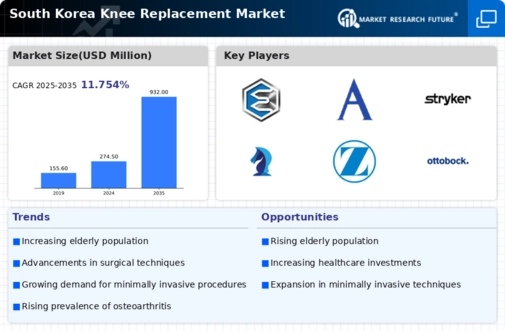Growing Awareness of Joint Health
There is a notable increase in public awareness regarding joint health and the benefits of knee replacement surgery in South Korea. Educational campaigns and community outreach programs are effectively informing individuals about the importance of maintaining joint health and the available treatment options for knee-related issues. As awareness grows, more patients are likely to seek consultations for knee pain and consider surgical interventions as viable solutions. This shift in perception is crucial for the knee replacement market, as it encourages proactive healthcare behaviors among the population. Additionally, the rise of social media and online health resources has facilitated the dissemination of information, further enhancing public knowledge. As individuals become more informed about their health choices, the demand for knee replacement surgeries is expected to increase, thereby driving market growth.
Advancements in Surgical Techniques
Innovations in surgical techniques are transforming the knee replacement market in South Korea. The introduction of robotic-assisted surgeries and computer navigation systems enhances precision and reduces recovery times for patients. These advancements not only improve surgical outcomes but also increase patient satisfaction, which is crucial in a competitive healthcare environment. Data suggests that minimally invasive techniques can reduce hospital stays by up to 50%, thereby lowering overall healthcare costs. As South Korean surgeons adopt these cutting-edge technologies, the knee replacement market is expected to expand, attracting more patients seeking effective and less invasive treatment options. Additionally, the training of medical professionals in these advanced techniques is likely to further stimulate market growth, as skilled surgeons can perform more complex procedures with greater confidence and efficiency.
Increasing Prevalence of Osteoarthritis
The rising incidence of osteoarthritis in South Korea is a primary driver for the knee replacement market. As the population ages, the prevalence of this degenerative joint disease escalates, leading to a higher demand for knee replacement surgeries. Recent statistics indicate that approximately 30% of individuals over 65 years old in South Korea suffer from osteoarthritis, which significantly impacts their quality of life. This growing patient demographic necessitates advancements in the knee replacement market, as healthcare providers seek effective solutions to manage pain and restore mobility. Furthermore, the economic burden associated with osteoarthritis treatment is substantial, prompting healthcare systems to invest in knee replacement procedures as a cost-effective long-term solution. Thus, the increasing prevalence of osteoarthritis is likely to propel the knee replacement market forward in South Korea.
Rising Sports Participation and Injuries
The increasing participation in sports and physical activities among South Koreans is contributing to a rise in knee injuries, thereby impacting the knee replacement market. As more individuals engage in high-impact sports, the incidence of knee injuries, including ligament tears and cartilage damage, is likely to increase. This trend is particularly evident among younger populations, who may require knee replacement surgeries earlier in life due to sports-related injuries. Data indicates that sports injuries account for a significant portion of knee-related health issues, prompting a need for effective surgical solutions. Consequently, the knee replacement market may experience growth as healthcare providers address the needs of active individuals seeking to regain mobility and return to their sports. This dynamic interplay between sports participation and knee health is expected to shape the future landscape of the market.
Government Initiatives and Healthcare Policies
Government initiatives aimed at improving healthcare access and affordability are significantly influencing the knee replacement market in South Korea. Policies that promote early diagnosis and treatment of joint disorders are likely to increase the number of patients seeking knee replacement surgeries. The South Korean government has implemented various health insurance schemes that cover a substantial portion of knee replacement costs, making the procedure more accessible to the general population. This financial support encourages individuals to opt for surgical interventions rather than conservative treatments, thereby driving market growth. Furthermore, public health campaigns aimed at raising awareness about joint health and the benefits of knee replacement surgery are expected to contribute positively to the market. As these initiatives continue to evolve, they may create a more favorable environment for the knee replacement market.



















Leave a Comment